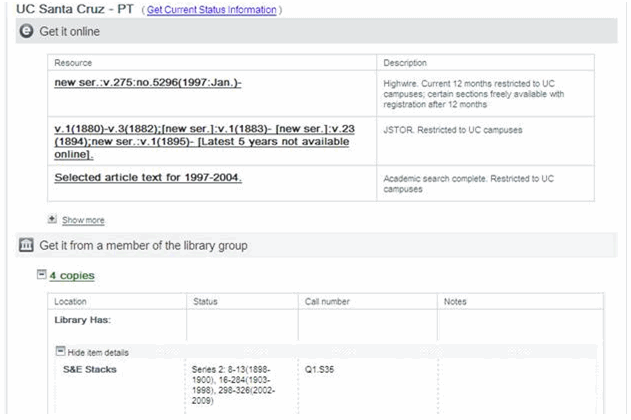Important Milestone: Serial Local Holdings Records (LHRs) to display in Melvyl
Since nearly the inception of the UC-OCLC Melvyl project, adding serial Local Holdings Records (LHRs) to UC’s Melvyl catalog records has been a high priority. The aim in doing so has been to improve response time, particularly for serial records with voluminous holdings. The Next-Generation Melvyl Local Bibliographic Data Task Group, led by Randal Brandt at Berkeley, was instrumental in making recommendations on which fields should be added to our records, as was the Joint Next-Generation Melvyl and Next-Generation Technical Service Task Group on LHRs for Serials led by Sara Layne at UCLA. Heads of Technical Services (HOTS) guided the process along the way. Many UC campus catalog and systems experts worked with OCLC over several months, carefully analyzing records to insure that high quality records were loaded into Melvyl.
This feature will be launched in the central and campus versions of Melvyl on Monday, September 12. Local campus holdings information for Berkeley and Davis will continue to be pulled from the campus ILS until loading of the LHRs for these campuses is complete. Other campuses may see reduced loads on their Z39.50 servers since the holdings for the serial records will be coming from the serial LHRs and not the local system.
Thanks are due to all those in the UC libraries and at OCLC who brought this project to fruition.
Details
When serial LHR display is enabled and an LHR exists for the record, Melvyl will display the serial LHR information with an option to query the ILS for real time detailed information, using a “Get Current Status Information” link next to the library name. If serial LHR display is enabled but no LHR exists for the record, Melvyl will display information from the campus ILS. See, for example, a partial UCSC record with LHRs enabled for the journal Science in Melvyl:

You will see that the print holdings are summarized instead of presented volume by volume.
CDL has taken the campus’s local ILS display name (as reported by the campus location table liaisons) as the display text for each LHR code. In the case that a campus chose one LHR code for multiple campus ILS locations, the campus location table liaison was asked to choose a single ILS location to correspond with the LHR code. If the campus location table liaison has yet to send the LHR code to CDL, the four character code will display instead of the human-readable name.
Problems?
If you find any problems with this feature, please report them to melvylops@cdl.org
